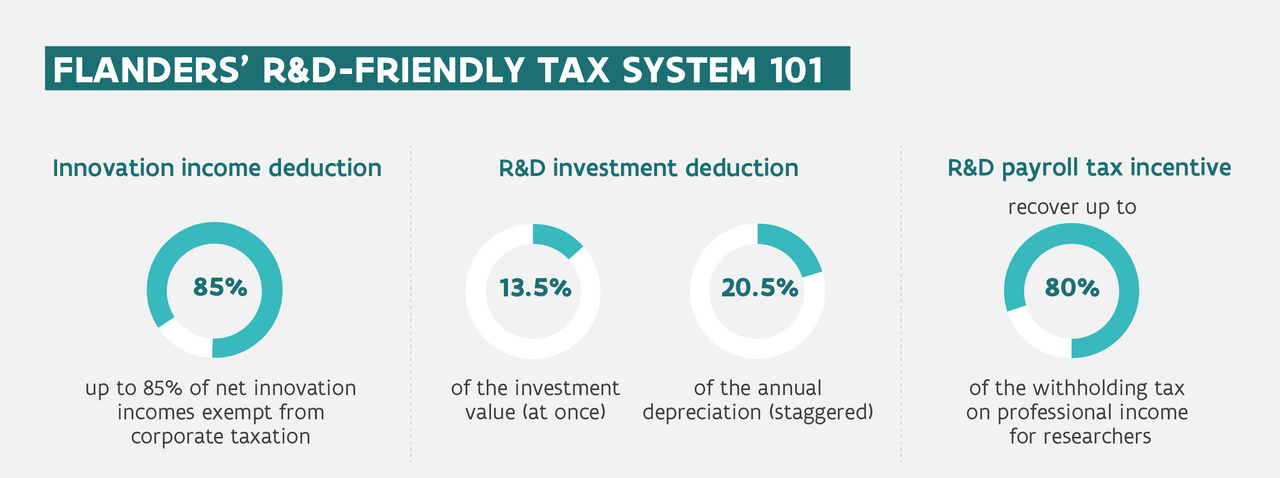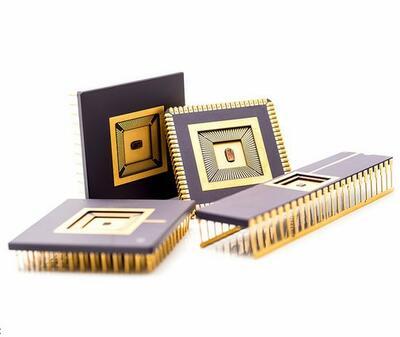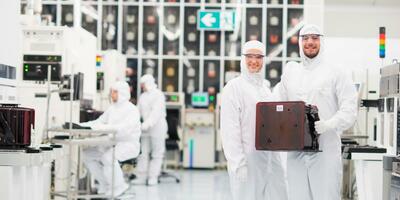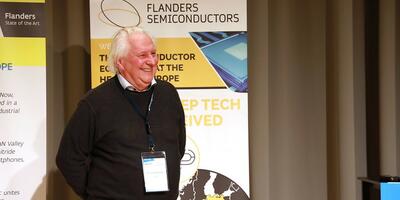
Micro- & nanoelectronics
Micro- and nanoelectronics are some of the key enabling technologies through which Europe aims to keep its competitive edge – and there’s nowhere they thrive better than in Flanders. Belgium’s northern region boasts expert know-how in the nanotech field, centered around its universities as well as imec, Flanders’ strategic research center for nanotech and digital innovation. A broad pool of start-ups and other innovative players serves as a bridge between this know-how and new applications such as smart textiles, revolutionary medical devices, biotechnological breakthroughs, digital innovations, etc.
An ecosystem for nanotech success
Flanders has all the building blocks for your micro- and nanotech innovations and applications. In addition to strong academic institutions and research institutes, the region is home to a broad variety of high-tech established and start-up companies that specialize in micro- and nanotechnologies. Together, they offer your business access to a creative pool of innovation for novel life sciences & health applications, smart city technologies and more.
Imec, strategic research center for nanotech and digital
Headquartered in Leuven, imec is Europe’s largest independent research and training center and boasts highly specialized expertise in microelectronics and nanotechnology for applications in ICT, automotive, life sciences & health, food and more. The strategic research center’s nanotech activities include:
- nano-CMOS and novel devices for nanoelectronics, micro- and nanoelectromechanical systems (MEMS and NEMS);
- nanomaterials and nanopatterning;
- nanoprobes, surface functionalization and self-assembly;
- molecular interconnects for molecular electronics and bioelectronic circuits;
- …
To top it all off, R&D at imec has a strong link with nanobiotech. One of its study areas is, for instance, the chemical and electronic nature of the interface between biospecimens and devices, as well as how signals can be transferred across that interface through self-assembled molecular layers.
NERF, neuro-electronics research initiative
Neuro-Electronics Research Flanders – NERF for short – is a non-profit academic research initiative powered by three world-class institutes: imec, VIB and KU Leuven. Combining cutting-edge technologies from biology, physics, engineering and computer science, NERF concentrates its research efforts on questions such as ‘How are neuronal circuits built?’, ‘How do they perform the computations that underlie perception, memory, thought and behavior?’ and ‘How does their dysfunction lead to disease?’.
VITO, multidisciplinary research for sustainability and cleantech
VITO specializes in the fields of cleantech and sustainable development. Specifically, the strategic research center is active in the development of nanostructured materials and surfaces, carbon nanotubes and graphene for various nanotech applications. These include multifunctional surfaces,
Knowledge partners for a variety of micro- and nanotech application domains
The application areas of microelectronics and nanotechnology are vast. In Flanders, various sectors can count on the support of research players that have nanotech as one of their focus areas. What’s more, Flanders opens up a network of R&D centers dedicated to some of the main micro- and nanotech application domains, ranging from textiles, coatings and materials to chemicals, biotech, health and photonics. Below, you can find just a handful of examples.
New materials
The micro- and nanotech scene has an important role to play in developing sustainable materials innovations. In Flanders, the Strategic Initiative Materials (SIM) is the region’s spearhead cluster for driving innovation, cocreation and partnerships in this fascinating R&D domain.
What’s more, various centers of expertise and research institutes in Flanders focus on this theme as well. These include:
- IMOMEC – The Hasselt-based Institute for Materials Research in MicroElectronics focuses its research on biosensors, wide-bandgap materials, organic synthesis, organic materials for electronic applications, precursors for nanomaterials, and much more.
- Sirris – With sites across Flanders, Sirris is a collective center of expertise for and by the technological industry. Among others, Sirris focuses on materials development.
- Centexbel – This Ghent-based research center for the textile industry is home to nanotech-related activities that focus on the nanoscale modification of textile surfaces, nanocoatings, nano-additives in fibers and coatings, nanofibers production through electrospinning and more.
|
Case in point: smart firefighter protective clothing Nanotech research center imec and Flanders-based textile producer Sioen have equipped a fire suit with smart sensors that measure the heat released in a fire. Through an intensifying sound signal, the sensors warn firefighters when they are exceeding their physical limits and running the risk of burns. The smart suit was developed at the request of the Paris Fire Brigade, the world’s third-largest fire department, which successfully tested the suit in fire simulations.
|
Chemicals
Innovative chemical applications abound in Flanders – and your nanotech business can capitalize on the region’s chemical R&D ecosystem, too! To highlight just one example of a research player that focuses on the cross-over between chemical and nanotech innovation, there’s Flamac.
Short for ‘Flanders Materials Center’, Flamac is a major competence center in high-throughput methodologies that support the materials industry. Its research includes the synthesis and characterization of submicron metal-oxide coatings through chemical vapor deposition.
|
Case in point: the screens of the future With the high-tech ink developed by three scientists in Ghent (Flanders), screens will show richer colors, consume less energy and become even thinner. “Thanks to our technology, on-screen landscapes will, for example, contain many more shades of green and look even more realistic,” says Kim De Nolf, CEO of Flanders-based start-up QustomDot. Together with two fellow UGent scientists, De Nolf developed eco-friendly quantum dots that will further improve the color purity of screens such as television and computer screens as well as those of smart clocks, smartphones and AR glasses. The innovation is based on indium phosphide and zinc sulfide, which is a more sustainable alternative to the current quantum dot used in high-end televisions. In addition, according to QustomDot, it is the first company to apply cadmium-free quantum dots directly to the LED chip. This enables the production of even thinner and more energy-efficient screens. |
Biotech
In Flanders, your nanotech business can choose from a myriad of biotech knowledge partners to co-create and innovate with, including the world-renowned research center VIB. The list is simply too long to cover here, but you can dive into the details by checking out our life sciences industry overview.
|
Case in point: biosensor chip for infectious disease surveillance US molecular electronics firm Roswell Biotechnologies partnered up with Flanders’ nanotech research center imec to develop the first commercially available molecular electronics biosensor chips. Roswell Biotechnologies is known for its sequencing platform, which supports innovative medical and healthcare approaches such as precision medicine, molecular diagnostics, rapid infectious disease testing and DNA data storage. “Our platform transforms the way infectious diseases are detected, enabling the rapid and simultaneous screening of many infectious diseases such as COVID-19 and viral strains, using only portable devices,” says Roswell CEO Paul Mola. “However, one of the main hurdles to commercializing molecular electronics is that it used to require expensive customized solutions for large-scale manufacturing. Imec has overcome this by coupling state-of-the-art semiconductor manufacturing tech with its deep experience in biosensor technology to commercialize molecular electronics using standard tools.” |
Photonics
Flanders’ photonics innovation ecosystem is highly accessible and open for R&D collaboration. One example is research institute B-PHOT, which is the result of a close collaboration between VUB and imec. This dedicated team focuses, among other things, on the development and prototyping of novel applications – including micro-lasers, non-linear photonics, freeform optics, optical fiber sensors, labs-on-a-chip and more.
|
Case in point: deciphering the Da Vinci code Using a hyperspectral camera developed by nanotech research center imec, American historian Jean-Pierre Isbouts investigated whether Leonardo Da Vinci was involved in painting a replica of one of his most famous works: The Last Supper, which can be found in the Santa Maria delle Grazie in Milan. Six years after Da Vinci’s original masterpiece was created, an exact copy was completed in the Abbey of Tongerlo, Flanders. Thanks to imec’s hyperspectral scans, Isbout’s team gained detailed information on the painting’s composition without making physical contact with the canvas. When studying the Tongerlo painting, Isbout noticed that the figure of John – the apostle sitting on Jesus’ left – is painted using the sfumato technique. This is the same method used in Da Vinci’s Mona Lisa painting. Isbouts argues that only De Vinci mastered this difficult technique enough to create the figure of John in the same way, referring to the work in Tongerlo Abbey as “a second Last Supper” rather than “a copy”. (Source: VRT News website) |
Financing your micro- and nanotech business in Flanders
If you decide to establish activities or headquarters in Flanders, your business can reap the rewards of:
- government subsidies and support for investments in R&D and innovation, strategic transformation, ecological efforts, growth and other domains.
- tax incentives to fund a broad range of business activities.
- fiscal options to help you cut labor costs.
- funds such as the KBC Focus Fund (which earmarks EUR 50 million for boosting nanotech, microelectronics and IoT innovation) and imec.expand (a growth fund for hardware-driven nanotech innovation).
Request a free copy of our brochure to discover more about government support in Flanders.
Specific incentives
Flanders offers access to several tax incentives that are particularly relevant to research-intensive activities such as micro- and nanotech. Examples include:
- the innovation income deduction – up to 85% of a company’s net innovation income can be exempt from corporate tax.
- the R&D investment deduction – 13.5% of the investment value (at once) or 20.5% of the annual depreciation (staggered).
- the R&D payroll tax exemption – 80% of the withholding tax on professional income for researchers and academic personnel.




